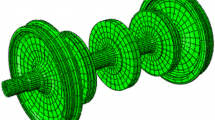Abstract
A track-wheel-terrain interaction model is presented in this paper, which can be used as a “force” super-element in a multibody dynamics code for dynamic simulation of tracked vehicles. This model employs a nonlinear finite element representation for the track segment that is in contact with the terrain and roadwheels, which can be used to simulate two different track systems, namely a continuous rubber band track and a multi-pitched metallic track, provided the finite element mesh in the track model is properly defined. The new track model accounts for the tension variations along the track (due to the non-uniformly distributed normal pressure and traction), track extensibility, and geometrically large (nonlinear) track deflections. A new solution algorithm is then proposed that includes an adaptive meshing method for representing track movement during the simulation for the multi-pitch tracks. Doing so produces a track model that captures high-frequency content of the track-wheel-terrain interaction, and it can more accurately describe the mechanics of a multi-pitch track as the vehicle negotiates rough terrain. The resulting track-wheel-terrain model combines approximate and known constitutive laws for terrain response with the new track representation, which allows the computation of the normal and shear forces, as well as the passage frequency, at the track-terrain interface. The track model and solution algorithm are further illustrated in this paper using a simple two-wheel system model and a full vehicle model of an M1A1 tank.
Similar content being viewed by others
References
Ma, Z.-D. and Perkins, N.C., ‘A track-wheel-terrain interaction model for dynamic simulation of tracked vehicles,’ Vehicle System Dynamics 37(6), 2002, 401–421.
Bekker, M.G., Theory of Land Locomotion. University of Michigan Press, Ann Arbor, MI, 1956.
Bekker, M.G., Introduction to Terrain-Vehicle Systems. University of Michigan Press, Ann Arbor, MI, 1969.
Wheeler, P., ‘Tracked vehicle ride dynamics computer program,’ SAE Paper 770048, 1977.
Doyle, G.R., Jr. and Workman, G.H. ‘Prediction of track tension when traversing an obstacle,’ SAE Paper 790416, 1979.
Garnich, M.R. and Grimm, T.R.,‘Modeling and simulation of a tracked vehicle,’ ASME Proceedings of the International Computers in Engineering Conference and Exhibit on Advanced Automation 2, 1984, 591–600.
Dhir, A. and Sankar, S., ‘Ride dynamics of high-speed tracked vehicles: simulation with field validation,’ Vehicle System Dynamics 23, 1994, 379–409.
Galaitsis, A.G., ‘TRAXION: A model for predicting dynamic track loads in military vehicles,’ Transaction of ASME, Journal of Vibration, Acoustics, Stress, and Reliability in Design 106, 1984, 286–291.
Choi, J.H., Lee, H.C. and Shabana, A.A., ‘Spatial dynamics of multibody tracked vehicles, part 1: spatial equations of motion,’ Vehicle System Dynamics 29, 1998, 27–49.
Choi, J.H., Lee, H.C. and Shabana, A.A., ‘Spatial dynamics of multibody tracked vehicles, part 2: contact forces and simulation results,’ Vehicle System Dynamics 29, 1998, 113–137.
Wong, J.Y., Garber, M. and Preston-Thomas, J., ‘Theoretical prediction and experimental substantiation of the ground pressure distribution and tractive performance of tracked vehicles,’ Proc. Instn Mech. Engrs 198(D15), 1984, 265–285.
Wong, J.Y., Terramechanics and Off-Road Vehicles. Amsterdam, The Netherlands, Elsevier Science Publishers B.V, 1989.
Wyk, D.J. van, Spoelstra, J. and Klerk, J.H. de, ‘Mathematical modeling of the interaction between a tracked vehicle and the terrain,’ Appl. Math. Modeling 20, 1996, 838–846.
Gao, Y. and Wong, J.Y., ‘The development and validation of a computer aided method for design evaluation of tracked vehicles with rigid links,’ Journal of Automobile Engineering 208, 1994, 207–215.
McCullough, M.K. and Haug, E.J., ‘Dynamics of high mobility track vehicles,’ Journal of Mechanisms, Transmissions, and Automation in Design 108, 1986, 189–196.
Scholar, C. and Perkins, N.C., ‘Longitudinal vibration of elastic vehicle track systems,’ SAE Paper No.971090, 1997.
Scholar, C., Ma, Z.D. and Perkins, N.C., ‘Modeling of tracked vehicles using a modal track representation: development and implementation,’ Proceedings of SAE Noise and Vibration Conference, Traverse City, Michigan, 1999, SAE P-342, pp. 1061–1068.
Assanis, D.N., Bryzik, W., Castanier, M.P., Darnell, I.M., Filipi, Z.S., Hulbert, G.M., Jung, D., Ma, Z.-D., Perkins, N.C., Pierre, C., Scholar, C.M., Wang, W. and Zhang, G., ‘Modeling and Simulation of an M1 Abrams Tank with advanced track dynamics and integrated virtual diesel engine,’ Mechanics of Structures and Machines 27(4), 1999, 453–505.
Janosi, Z. and Hanamoto, B., ‘The analytical determination of drawbar pull as a function of slip for tracked vehicles in deformable soils,’ Proceedings of the First International Conference on Terrain-Vehicle Systems, Torino, Italy, 1961.
Author information
Authors and Affiliations
Rights and permissions
About this article
Cite this article
Ma, ZD., Perkins, N.C. A Super-Element of Track-Wheel-Terrain Interaction for Dynamic Simulation of Tracked Vehicles. Multibody Syst Dyn 15, 347–368 (2006). https://doi.org/10.1007/s11044-005-9001-3
Received:
Accepted:
Published:
Issue Date:
DOI: https://doi.org/10.1007/s11044-005-9001-3




